Physical Address
304 North Cardinal St.
Dorchester Center, MA 02124
This early lethal disorder was described in 1925 by Donath and Vogl and termed achondrogenesis by Fraccaro in 1952. More than 20 cases have been reported. Studies by Borochowitz and colleagues indicate that achondrogenesis type I (previously referred to as Parenti-Fraccaro type) represents two radiographically and histopathologically distinct disorders, referred to as types IA and IB. In the classification set forth by Whitley and Gorlin, type I is synonymous with type IA and type II with type IB.
Growth. Extremely small stature (22 to 30 cm).
Craniofacial. Cranium large for gestational age, low nasal bridge, micrognathia.
Limbs. Severe micromelia.
Radiographs. In both types, the skull, vertebral bodies, fibula, talus, and calcaneus are poorly ossified; the ilia are crenated; the long bones are stellate; and the ribs are extremely short. In type IA, multiple rib fractures are present, and the proximal femora have metaphyseal spikes. Conversely, in type IB, rib fractures do not occur, and the distal femora have metaphyseal irregularities.
The defect in the development of cartilage and bone is severe. In type IA, normal-appearing but a hypervascular cartilage matrix is present with increased cellular density. Large lacunae surround the chondrocytes, which contain round cytoplasmic inclusion bodies. In type IB, sparse interterritorial cartilaginous matrix is present, with a marked deficiency of collagen fibers. The chondrocytes are large, have a central round nucleus, and are surrounded by a dense collagenous ring. Developmental pathology beyond the skeletal system is implied by the frequent findings of polyhydramnios, hydrops, and early lethality. Most infants are stillborn or die shortly after birth. Occipital encephalocele has been reported in one child with type IA disease.
This disorder has an autosomal recessive inheritance pattern. Achondrogenesis type IA is caused by mutations in the thyroid hormone receptor interactor gene ( TRIP11 ), which leads to a deficiency of Golgi microtubule-associated protein 210 (GMAP-210) in chondrocytes. Achondrogenesis type IB is caused by mutations in the diastrophic dysplasia sulfatase transporter (DTDST) gene ( SLC26A2 ). Inactivation of the gene product, a sulfate-chloride exchanger of the cell membrane, leads to intracellular sulfate depletion and to synthesis of undersulfated proteoglycans in susceptible cells. Mutations in this gene are responsible for four recessively inherited chondrodysplasias, including achondrogenesis type IB, diastrophic dysplasia, multiple epiphyseal dysplasia, and atelosteogenesis type II.
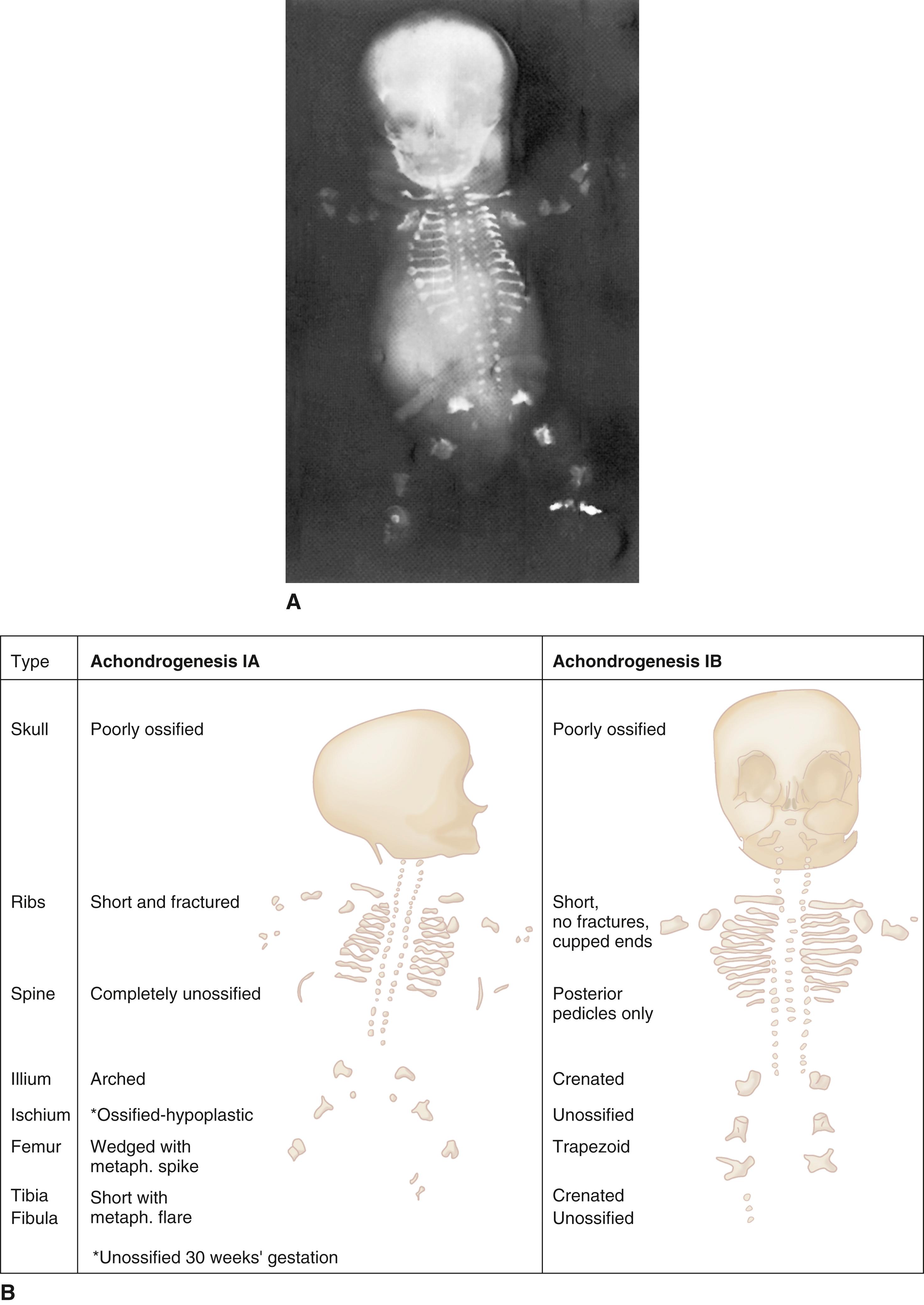
Initially described by Langer and colleagues and Saldino, this early lethal disorder has been more completely delineated by Chen and colleagues and Borochowitz and colleagues.
Growth. Extremely short stature (27 to 36 cm).
Craniofacial. Large calvarium with large anterior and posterior fontanels, flat nasal bridge, small anteverted nostrils, micrognathia.
Limbs. Short.
Radiographs. Normal cranial ossification; short ribs without fractures; short, broad long bones with disproportionately long fibula and metaphyseal irregularity of distal ulna; variable degrees of failure of ossification of lumbar spine, cervical spine, sacrum, ischial and pubic bones, and calcaneus and talus.
Other. Polyhydramnios.
Cleft soft palate, microtia, postaxial polydactyly of feet, cystic hygroma, hydrops, diverticulosis of proximal small bowel, atrial septal defect, atrioventricular canal defect.
Although one child survived to 3 months, the majority are stillborn or die in the first few hours of life from pulmonary hypoplasia.
The vast majority of cases are sporadic. Molecular studies have documented mutations of COL2A1, the gene encoding type II collagen. In all cases where mutations have been identified, they have been heterozygous, indicating an autosomal dominant mode of inheritance. A number of examples of more than one affected child in a family born to unaffected parents have been reported and are felt to be the result of germline mosaicism. Mutations in the gene for type II collagen result in distinct clinical disorders known as type II collagenopathies, with a clinical spectrum ranging from mild to perinatal lethal, including Stickler syndrome, spondyloepimetaphyseal dysplasia, Strudwick type, Kniest dysplasia, spondyloepiphyseal dysplasia congenita, and type II achondrogenesis-hypochondrogenesis.
Hypochondrogenesis, previously thought to be a distinct disorder, and achondrogenesis type II represent a spectrum of the same disorder referred to as type II achondrogenesis-hypochondrogenesis. Patients with the most severe radiographic and pathologic features have been labeled achondrogenesis type II, whereas those with less severe, although similar features, are labeled hypochondrogenesis.
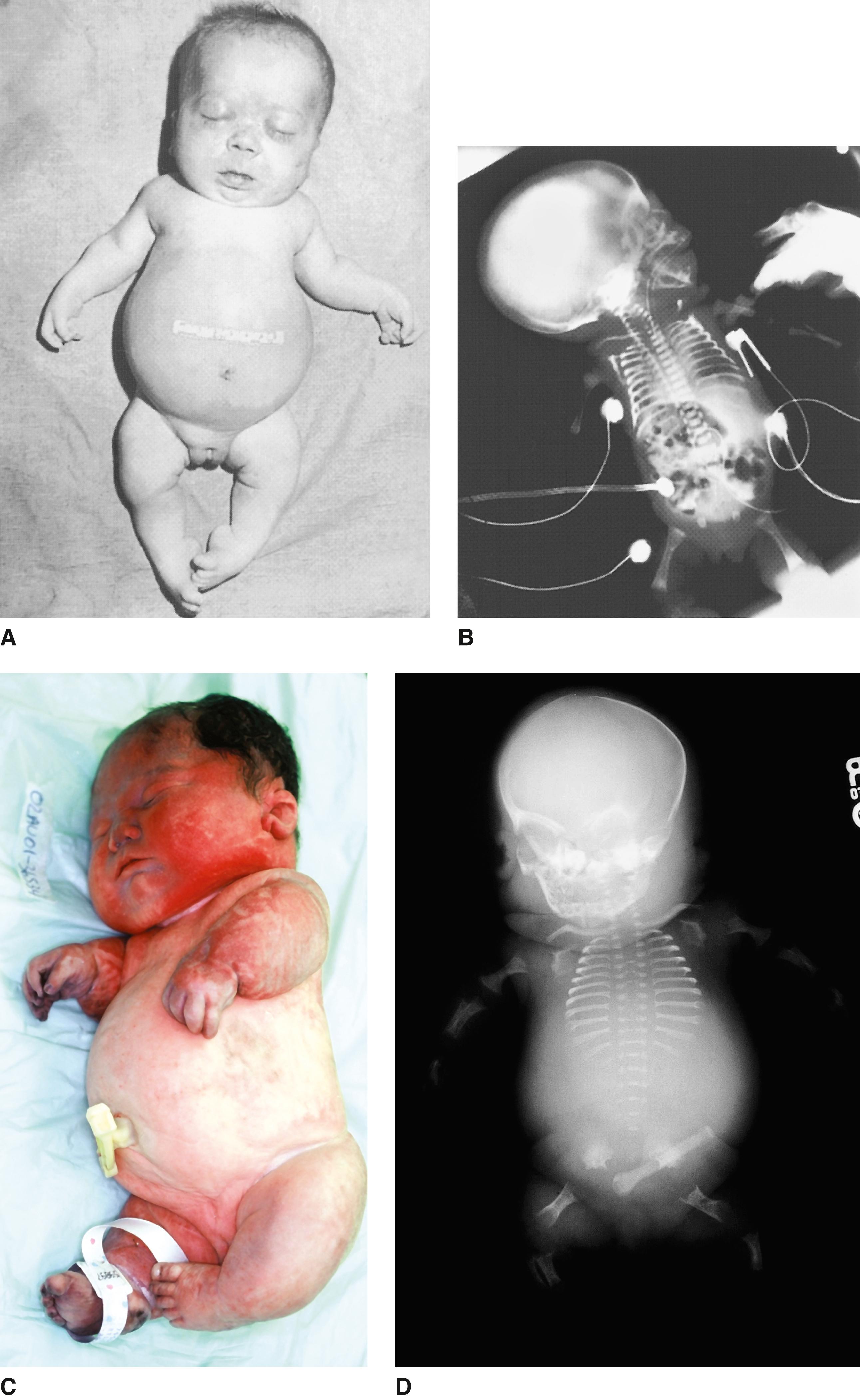
Lazzaroni-Fossati described a patient with this early lethal disorder in 1978. Subsequently, approximately 13 additional patients have been reported. A distinctive fibrosis of the growth-plate cartilage led to the designation fibrochondrogenesis.
Growth. Short stature.
Craniofacial. Widely patent anterior fontanel, coronal and sagittal sutures; protuberant eyes with large corneae; hypoplastic nose with flat nasal bridge and anteverted nares; long philtrum; small mouth; cleft palate; short neck; low-set, malformed ears.
Trunk. Flattened vertebrae with posterior vertebral hypoplasia and a sagittal midline cleft; short, thin ribs with anterior and posterior cupping; long, thin clavicles; small chest; small/elevated scapula.
Limbs. Rhizomelic shortening; small hands and feet; camptodactyly; fifth-finger clinodactyly; hypoplastic finger and toenails; short, dumbbell-shaped long bones with broad, irregular metaphyses; prominent metaphyseal spurs adjacent to growth plates; short fibulae.
Pelvis. Hypoplastic with ovoid ilia, irregular flattened acetabula with medial spikes and narrow sacrosciatic notches; broad, hypoplastic ischii.
Other. Omphalocele, hydrops.
The vast majority of affected individuals have been stillborn or have died in the neonatal period.
There are both autosomal dominant and autosomal recessive forms of this disorder. Mutations in the gene encoding the proa1(XI) chain of type XI collagen, COL11A1, are responsible for the recessively inherited mutations; mutations in the gene encoding the proa2 (XI) chain of type XI collagen, COL11A2, are responsible for the dominantly inherited mutations.
Microscopic examination of long bones demonstrates gross disorganization of growth plate cartilage, fibrous appearance of the matrix, and normal metaphyseal and diaphyseal bone formation.
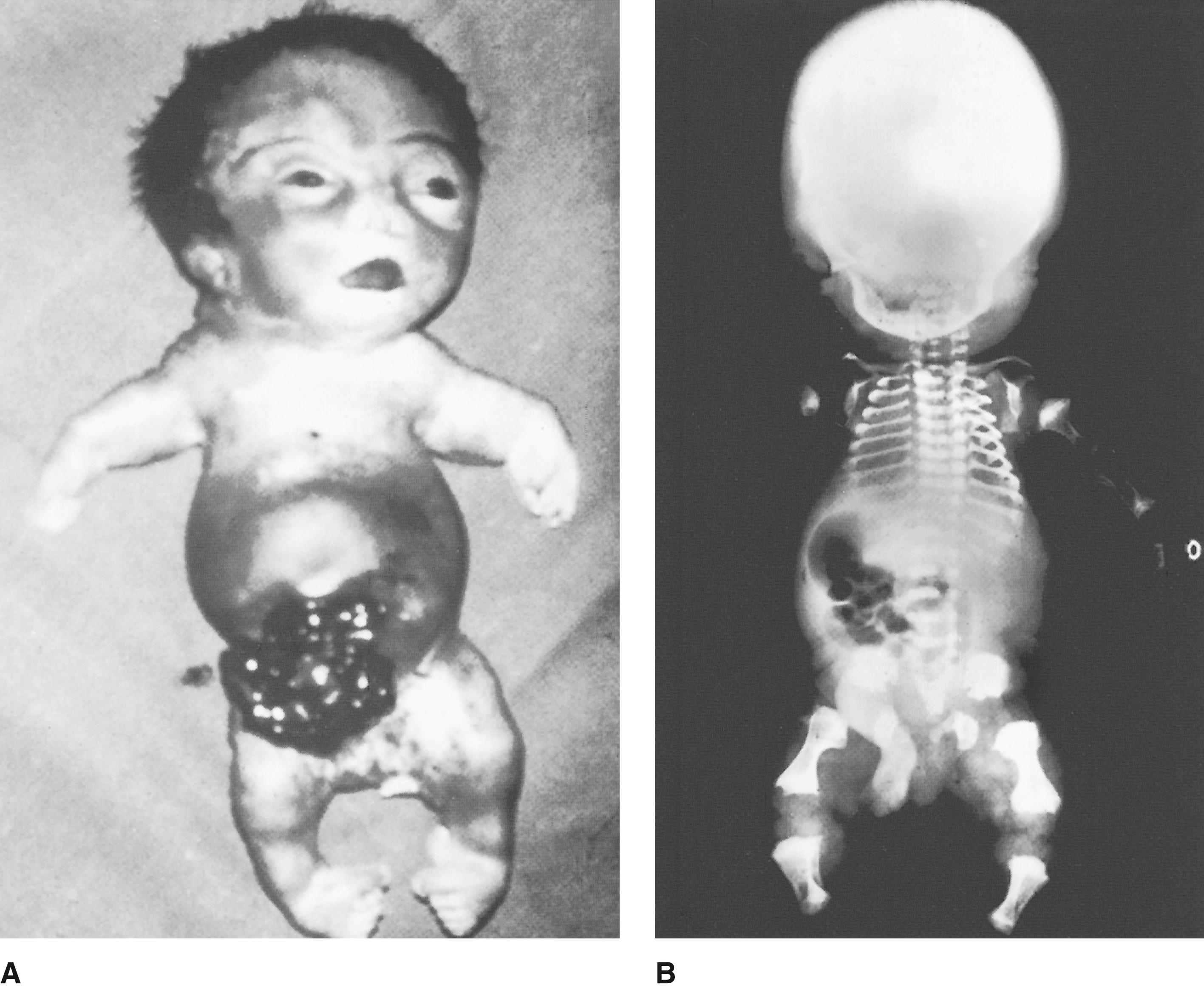
This early lethal short-limbed dwarfing condition was set forth by Maroteaux and colleagues and Sillence and colleagues. Atelosteogenesis derives from the Greek word for “incomplete” and relates to the marked lack of complete ossification of certain bones. It is now clear that atelosteogenesis is heterogeneous with three types (I, II, and III).
Growth. Short stature with proximal shortness of limbs.
Radiographs. Humeri are absent, segment-shaped, or distally tapered; absent fibula; short, distally pointed femora; bowed tibiae; abnormally segmented and fused cervical vertebrae; thoracic platyspondyly with multiple coronal clefts throughout; 11 pairs of ribs; narrow thoracic cage; hypoplasia of ischiopubis and flared ilia; lack of ossification of calcaneal centers; markedly delayed ossification of proximal phalanges and middle phalanges with well-ossified distal phalanges.
Other. Ocular hypertelorism, depressed nasal bridge, midface hypoplasia, micrognathia, macroglossia, multiple large joint dislocations, talipes equinovarus, polyhydramnios.
Cleft palate, laryngeal stenosis, retinal dysplasia involving the optic disc, macrocephaly, renal mcrocysts, abnormal branching of pancreatic dust, malrotation of caecum.
All affected infants have been stillborn or have died immediately after birth.
This disorder has an autosomal dominant inheritance pattern with all cases representing fresh gene mutations. Mutations in the gene encoding filamin B ( FLNB ) located at chromosome 3p14.3 are responsible. FLNB seems to have an important role in vertebral segmentation, joint formation, and endochondral ossification.
Mutations in FLNB include a spectrum of disorders ranging from mild (spondylocarpotarsal synostosis syndrome and Larsen syndrome) to severe (atelosteogenesis types I and III and boomerang dysplasia).
There is a flat face, ocular hypertelorism, a depressed nasal bridge, and cleft palate. The neck is short, the chest small, and the abdomen protuberant. There is shortening of proximal and distal bones of the limbs, radial deviation of the thumb, and a large gap between toes 1 and 2. Neonatal death is uniform and related to pulmonary hypoplasia, tracheobronchomalacia, and a malformed stenotic larynx. Radiographic features include platyspondyly, cervical kyphosis, hypoplasia/dysplasia of vertebrae, short ribs, glenoid hypoplasia, horizontal acetabula, bifid or V-shaped humerus, rounded distal femora, bowing of radius and tibia, and hypoplasia/dysplasia of tubular bones of hands and feet. Mutations in the diastrophic dysplasia sulfatase transporter (DTDST) gene ( SLC26A2 ) are responsible. Inactivation of the gene product, a sulfate-chloride exchanger of the cell membrane, leads to intracellular sulfate depletion and to synthesis of undersulfated proteoglycans in susceptible cells. Mutations in this gene are responsible for four recessively inherited chondrodysplasias, including atelosteogenesis type II, achondrogenesis type IB, diastrophic dysplasia, and multiple epiphyseal dysplasia.
There is a flat face, ocular hypertelorism, a depressed nasal bridge and anteverted nares, micrognathia with a small mouth and cleft palate, a narrow chest, rhizomelic shortness of arms and legs, dislocation of large joints, syndactyly, camptodactyly, polydactyly, and clinodactyly, broad nails, clubfoot, and scoliosis. Low-set ears, helix hypoplasia, and stenotic ear canals, hypotonia, hydrocephalus, and seizures occur less frequently. Radiographically, in comparison with type I, there is better ossification of the vertebrae; ossified fibulae are usually present and the metacarpals and phalanges are uniformly ossified. Respiratory and feeding difficulties are common in infancy. Respiratory complications and cervical spine instability often lead to death in the newborn period. However, survival to adulthood has been documented in one case, a woman who subsequently gave birth to an affected child. Inheritance is autosomal dominant, with most cases representing fresh gene mutations. Mutations occur in the gene encoding filamin B ( FLNB ). FLNB seems to have an important role in vertebral segmentation, joint formation, and endochondral ossification.

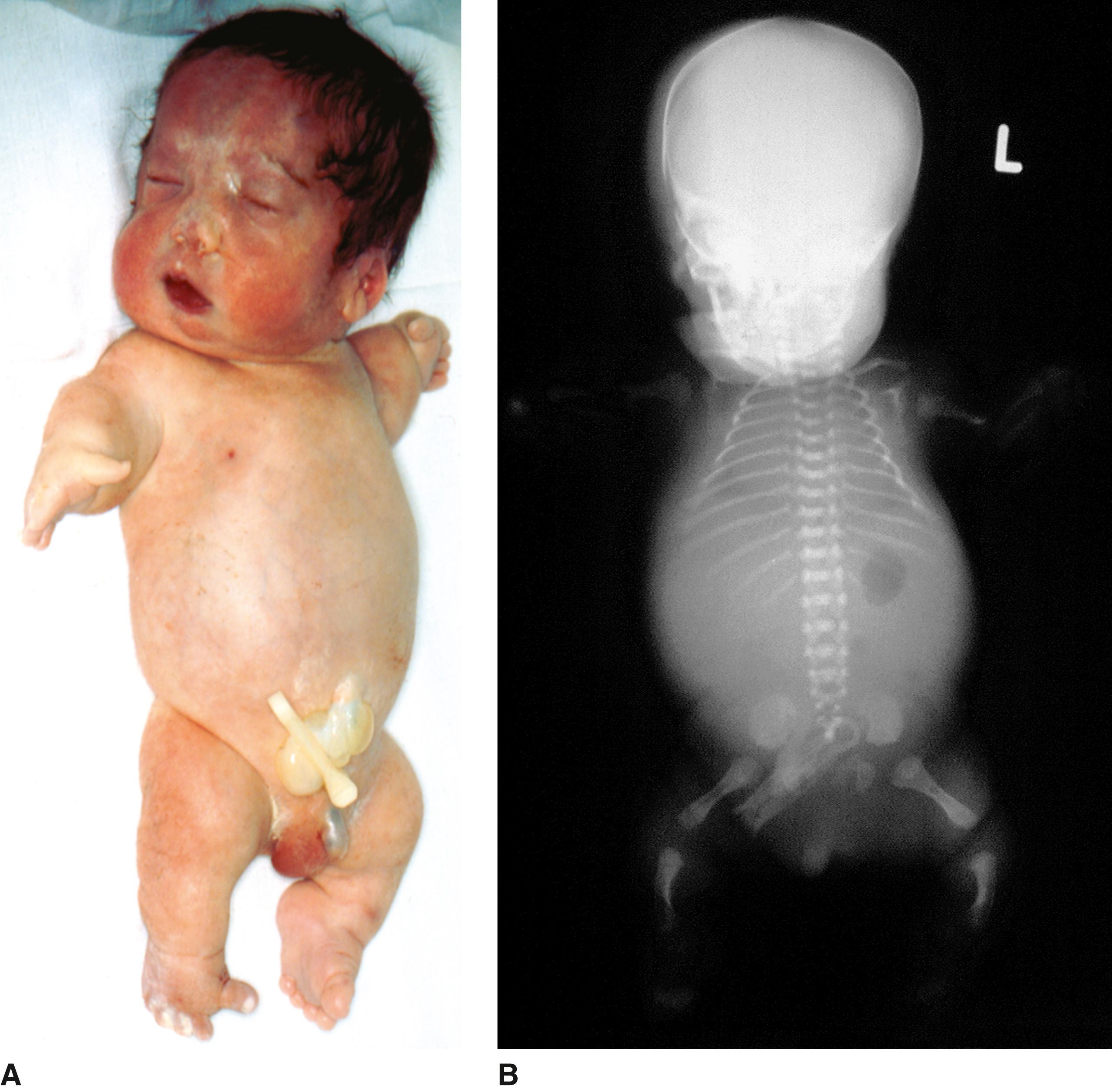
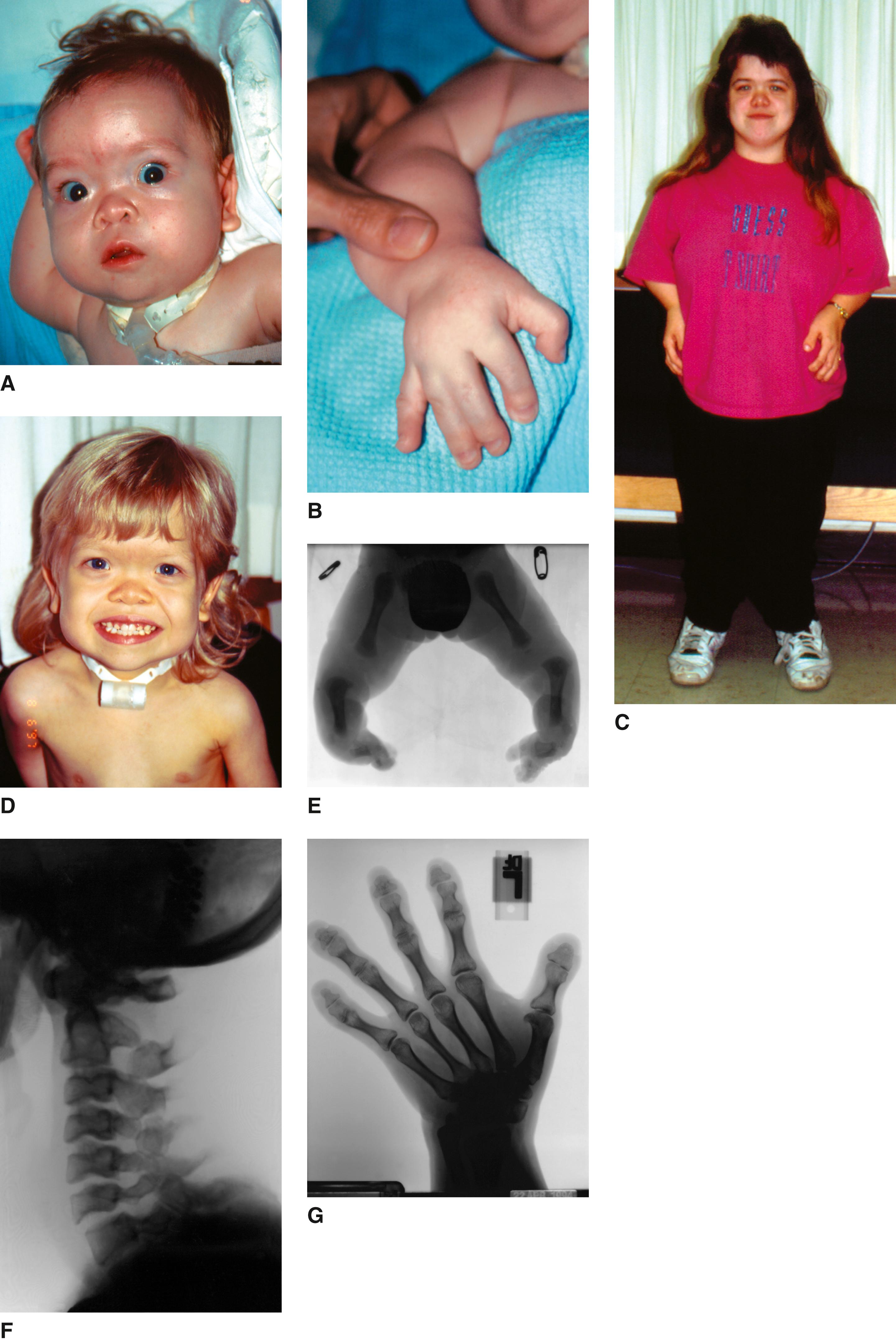
This lethal, short-limbed dwarfing syndrome is characterized by diminished and irregular ossification of the limb bones and vertebrae. The designation “boomerang dysplasia” is generally attributed to Kozlowski and colleagues, who noticed the typical boomerang-like shape of the long tubular bones. The disorder was clinically classified within the spectrum of the atelosteogenesis syndromes, and the finding of filamin B ( FLNB ) mutations by Bicknell and colleagues in 2005 confirmed this nosology.
Growth. Severe prenatal growth retardation secondary to limb and trunk shortening with sparing of head.
Craniofacial. Large fontanels, full forehead, hypertelorism, markedly depressed nasal bridge with horizontal groove, hypoplastic nasal septum, micrognathia, short neck with excess skin.
Trunk. Marked thoracic hypoplasia.
Limbs. Severe micromelia, usually symmetric; abnormal position of the limbs, commonly formed by a single segment; absence of discernible joints; talipes equinovarus.
Hands and Feet. Brachydactyly; broad, paddle-shaped hands. The hands and feet are short and broad and have shortened fingers and toes with poly- or oligodactyly, syndactyly, and hypoplastic nails.
Genitalia. Undescended testes.
Radiographs. Variable delayed calvarial ossification, relative preservation of the thorax, clavicles, sternum, and iliac wings with severe delay in mineralization of the vertebrae, pubis, metacarpal/tarsals, and long tubular bones of the arms and legs, boomerang-shaped femora.
Craniosynostosis, omphalocele, frontal encephalocele, cleft palate, cardiac defect.
Prenatally polyhydramnios, narrow thorax, short limbs, and defective ossification of the vertebrae and limbs are evident on ultrasound examination. Most are stillborn or die shortly after birth of respiratory insufficiency secondary to pulmonary hypoplasia.
This disorder has an autosomal dominant mode of inheritance, with all cases representing fresh gene mutations. Mutations in the gene encoding filamin B ( FLNB ) located at chromosome 3p14 are responsible.
FLNB is mutated in a spectrum of phenotypes ranging from spondylocarpotarsal synostosis (SCT) syndrome and Larsen syndrome at the mild end, and atelosteogenesis types I and III and boomerang dysplasia at the severe end. Boomerang dysplasia is distinguished from atelosteogenesis on the basis of a more severe defect in mineralization, with complete absence of ossification in some limb bones and vertebrae. Heterozygous mutations associated with the most severe phenotypes almost invariably occur in exons 2 to 5. These are apparently de novo , but germline or somatic mosaicism has been reported for the milder phenotypes. Flnb -deficient mice closely resemble those of human skeletal disorders with mutations in FLNB . Histology shows disorganized cartilage of the developing long bone and multinucleated chondrocytes in areas of a hypocellular cartilage matrix.
At the most severe end of the FLNB -related skeletal disorders is the Piepkorn type of osteochondrodysplasia. The principal features of that early lethal disorder include underossification of the skeleton associated with extremely short flipper-like limbs, short ribs, polysyndactyly, craniosynostosis, a prominent forehead, ocular hypertelorism, prominent eyes, an upturned nose, microstomia, Pierre-Robin sequence, and posteriorly rotated, low-set ears. Omphalocele, CNS defects, cardiac defects, and urogenital abnormalities have also been seen.
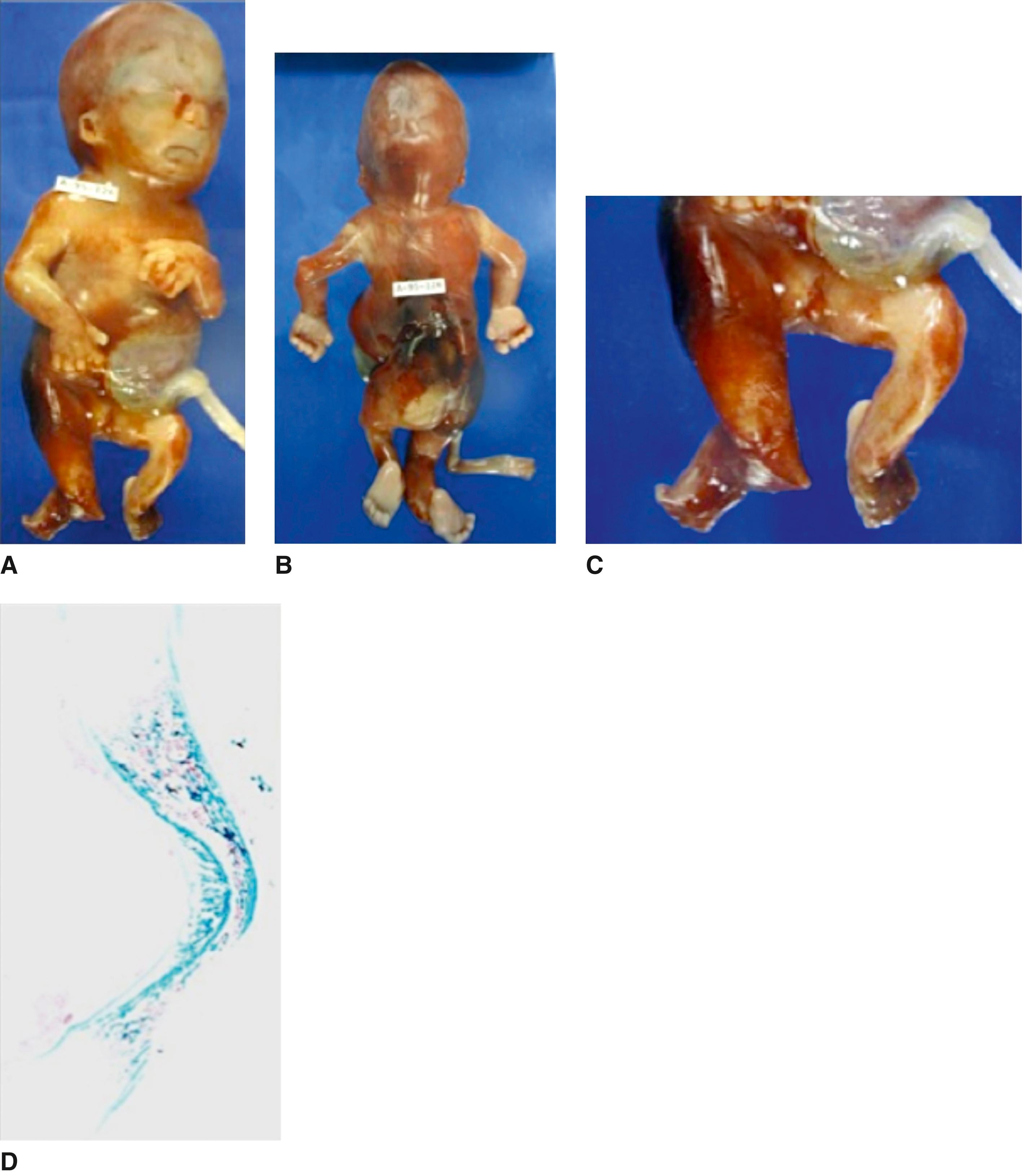
The short rib–polydactyly syndromes (SRPs) represent a group of conditions belonging to the ciliopathies. Primary cilia play an important role in transduction of signals in the hedgehog pathway that is of critical importance in skeletal development. The eight disorders belonging to this group are SRP I (Saldino-Noonan type), SRP II (Majewski type), SRP III (Verma-Naumoff type), SRP IV (Beemer-Langer type), Jeune thoracic dystrophy, Ellis–van Creveld (EvC) syndrome, Sensenbrenner syndrome, and Weyer acrofacial dysostosis. (Weyer acrofacial dysostosis is not covered in this book.) All of the SRPs are autosomal recessive lethal conditions. Death from respiratory insufficiency secondary to pulmonary hypoplasia has occurred in all infants in the first few days of life.
Growth. Short stature.
Limbs. Short; postaxial polydactyly of hands or feet; syndactyly; metaphyseal irregularities of long bones, with spurs extending longitudinally from medial and lateral segments; underossified phalanges.
Trunk. Short, horizontal ribs; notch-like ossification defects around the periphery of vertebral bodies.
Pelvis. Small iliac bones with horizontal acetabular roof, triangular ossification defect above lateral aspect of acetabulum.
Other. Cardiac defects, including transposition of great vessels, double-outlet left ventricle, double-outlet right ventricle, endocardial cushion defect, and hypoplastic right heart; pulmonary defects; micrognathia; polycystic kidneys; hypoplasia of penis; defects of cloacal development; imperforate anus.
Natal teeth, preaxial polydactyly, sex-reversal (phenotypic females with a 46XY karyotype).
This disorder, the most severe of the SRPS phenotypes, has an autosomal recessive inheritance pattern. Mutations in DYNC2H1, which encodes the main component of the retrograde IFT A motor cytoplasmic dynein 2 heavy chain 1, are responsible.
Growth. Short stature with disproportionately short limbs.
Craniofacial. Midline cleft lip; cleft palate; short, flat nose; low-set, small, malformed ears.
Limbs. Both preaxial and postaxial polysyndactyly of hands or feet; brachydactyly; disproportionately short, oval-shaped tibiae; short, rounded metacarpals and metatarsals; premature ossification of proximal epiphyses of humeri, femora, and lateral cuboids; underossified phalanges.
Trunk. Narrow thorax; short, horizontal ribs; high clavicles.
Other. Ambiguous genitalia; hypoplasia of epiglottis and larynx; multiple glomerular cysts and focal dilatation of distal tubules of kidney.
Microglossia; lobulated tongue; absent gallbladder; brain anomalies, including pachygyria, a small vermis, enlarged cisterna magna, ventriculomegaly, and absence of olfactory bulbs; persisting left superior vena cava; polyhydramnios.
This disorder has an autosomal recessive inheritance pattern. Mutations in NEK1 and DYNC2H1 are both responsible for SRP type II. NEK1 encodes a protein that functions in DNA-double strand repair, neuronal development, and coordination of cell-cycle-associated ciliogenesis. DYNC2H1 encodes a cytoplasmic dynein protein involved in retrograde transport in the cilia and functions in intraflagellar transport. Mutations in DYNC2H1 are also responsible for SRP type I, SRP type III, and Jeune thoracic dystrophy. In addition, mutations in TIC21B as well as mutations in IFT80 were found in rare cases of SRP type II.
Growth. Short stature.
Limbs. Short, bowed femora and humeri with cortical thickening of inner midshaft; metaphyses are broad and cupped with osseous spurs projecting laterally in femora, humeri, and phalanges.
Trunk. Narrow and cylindric with short, horizontal ribs; normally structured vertebral bodies, although pedicles of the vertebral arches appear plump; scapulae are square.
Pelvis. Small, square-shaped iliac bones.
Other. Macrocephaly; heart, intestine, genitalia, liver, and pancreas anomalies; visceral heterotopia.
Postaxial polydactyly, cleft palate, hypoplastic penis.
This disorder has an autosomal recessive inheritance pattern. Mutations in IFT80 and DYNC2H1 are responsible. IFT80 encodes a protein that is important in intraflagellar transport and is essential for the development and maintenance of motile and sensory cilia. DYNC2H1 encodes a cytoplasmic dynein protein involved in retrograde transport in the cilia and functions in intraflagellar transport. Mutations in both of these genes have been identified in Jeune thoracic dystrophy, suggesting that they are variants of the same condition.
Growth. Short stature.
Limbs. Short, with smooth metaphyseal margins; nonovoid tibia; tibial bones longer than fibular bones; bowed radius and ulna; metaphyseal bones are smooth without irregularities or spiking.
Trunk. Narrow and cylindric with short, horizontal ribs; high clavicles; small scapulae.
Pelvis. Small ilia with trident acetabula.
Other. Anomalies of the cardiovascular system, intestinal malrotation, multicystic pancreas, accessory spleen, omphalocele.
Ocular hypertelorism, retinal coloboma, lobulated tongue, midline cleft lip, cleft palate, accessory frenula, palate, micropenis, multicystic kidneys, polymicrogyria, corpus callosum agenesis, hydrocephaly, cerebellar hypoplasia, hamartoma of hypothalamus, biliary system abnormalities.
This disorder has an autosomal recessive pattern of inheritance. Mutations in NEK1 , TTC21B , WDR19 , and IFT80 have been identified. With the exception of WDR19 , mutations in the other three genes have been identified in patients with both SRP type II and SRP type IV, demonstrating that SRP II and SRP IV are allelic.
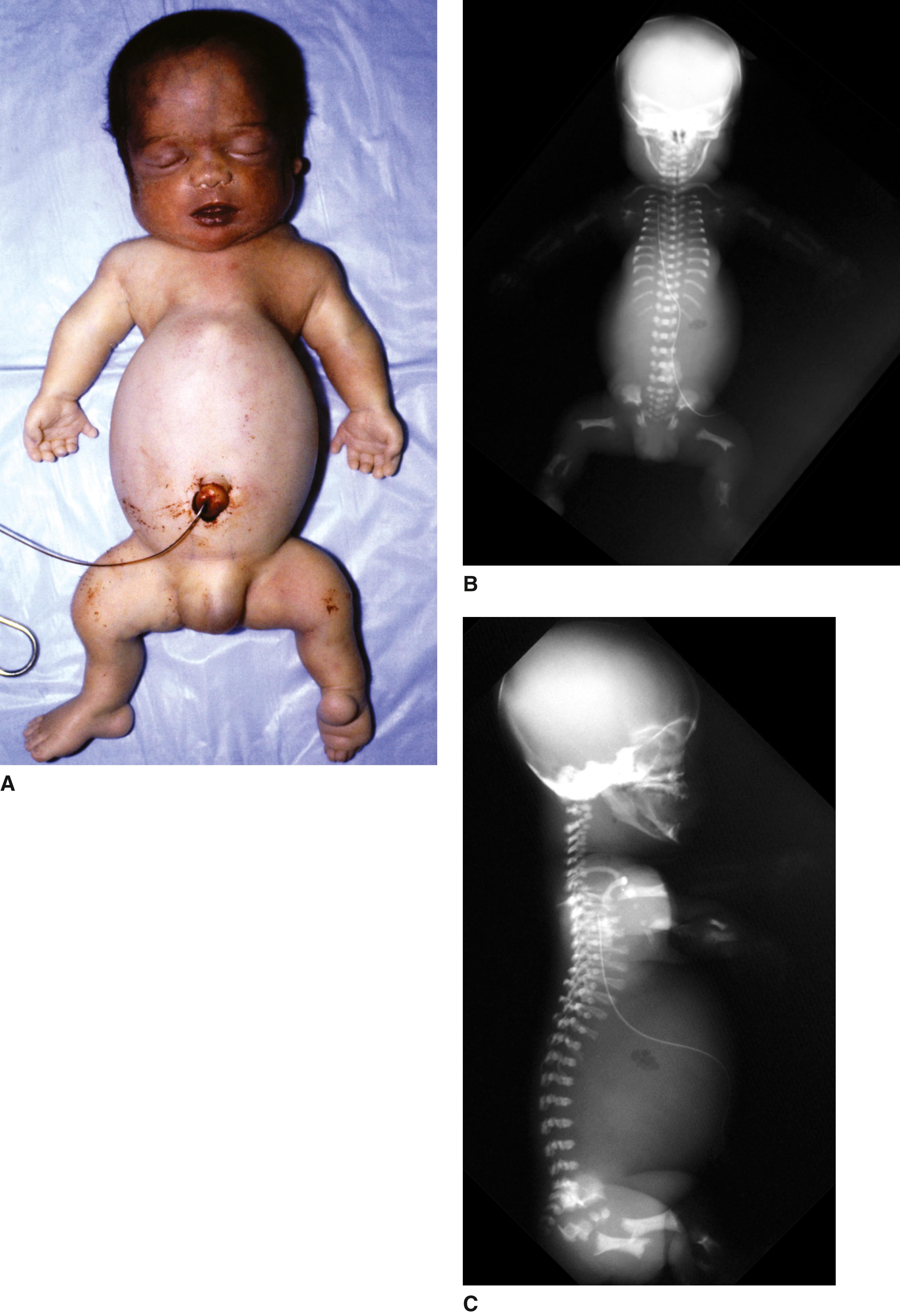
Maroteaux and colleagues set forth this disorder in 1967 and used the Greek term thanatophoric (“death-bringing”) to emphasize that such patients usually die shortly after birth. Langer and colleagues separated this condition into two types. Type I (TDI), which is most common, is characterized by curved long bones (most obviously the femora), and very flat vertebral bodies (≤35% of the adjacent disc space in the lumbar region). Type II (TDII) is characterized by straight femora and taller vertebral bodies. Almost all cases of thanatophoric dysplasia with a severe cloverleaf skull (the kleeblattschädel anomaly) are TDII.
Central Nervous System. Severe abnormalities, the most common of which is temporal lobe dysplasia; other defects include megalencephaly, hydrocephalus, encephalocele; semilobar holoprosencephaly, brainstem hypoplasia, maldevelopment of inferior olivary and cerebellar dentate nuclei; hypotonia; severe intellectual disability in the few survivors.
Growth. Severe growth deficiency; 36 to 46 cm tall, with an average of 40 cm.
Craniofacial. Large cranium and fontanel; 36 to 47 cm, average of 37 cm; small foramen magnum and short base of skull, with full forehead, low nasal bridge, bulging eyes, and small facies; cloverleaf skull.
Limbs. Short, with small sausage-like fingers, bowed long bones with cupped spur-like irregular flaring of metaphyses and lack of ossification in secondary centers at knee; fibulae are shorter than tibiae; disorganized chondrocytes and bony trabeculae, especially in central epiphyseal–metaphyseal region.
Thorax. Narrow with short ribs.
Spine. Short, flattened vertebrae with relatively wide intervertebral disk space; lack of caudal widening of spinal canal.
Scapulae. Small and square.
Pelvis. Square and short, with small sciatic notch and medial spurs; accessory ossification centers in the ischia and ilia at gestational age younger than 24 weeks.
Patent ductus arteriosus, atrial septal defect, horseshoe kidney, hydronephrosis, imperforate anus, chylous ascites, radioulnar synostosis, soft tissue syndactyly of fingers and toes, acanthosis nigricans in long-term survivors.
Feeble fetal activity and polyhydramnios are frequent in this disorder. These patients usually die shortly after birth, partially owing to the small thoracic cage and respiratory insufficiency. Although survival beyond the neonatal period is rare, a few affected individuals have been reported, one up to 28 years of age. All had profound developmental delay, severe growth deficiency, and were ventilatory-dependent.
This disorder has an autosomal dominant inheritance pattern. All cases represent fresh gene mutations, and most, if not all, are caused by mutations in the fibroblast growth factor receptor 3 ( FGFR3 ) gene. All cases with a Lys650Glu substitution had straight femora with craniosynostosis and frequently a cloverleaf skull (TDII). All other mutations were associated with curved femora; cloverleaf skull was present only infrequently (TDI).
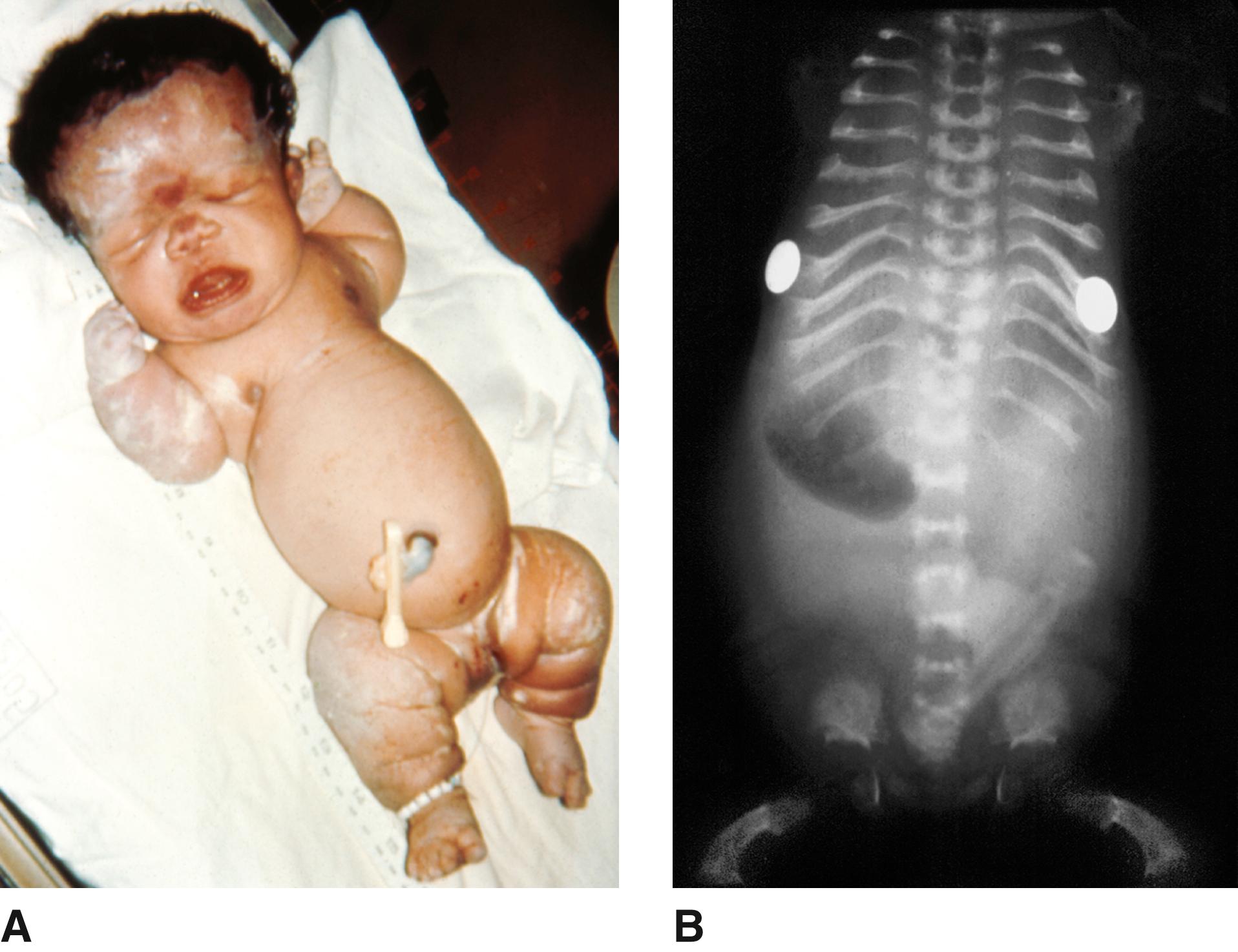
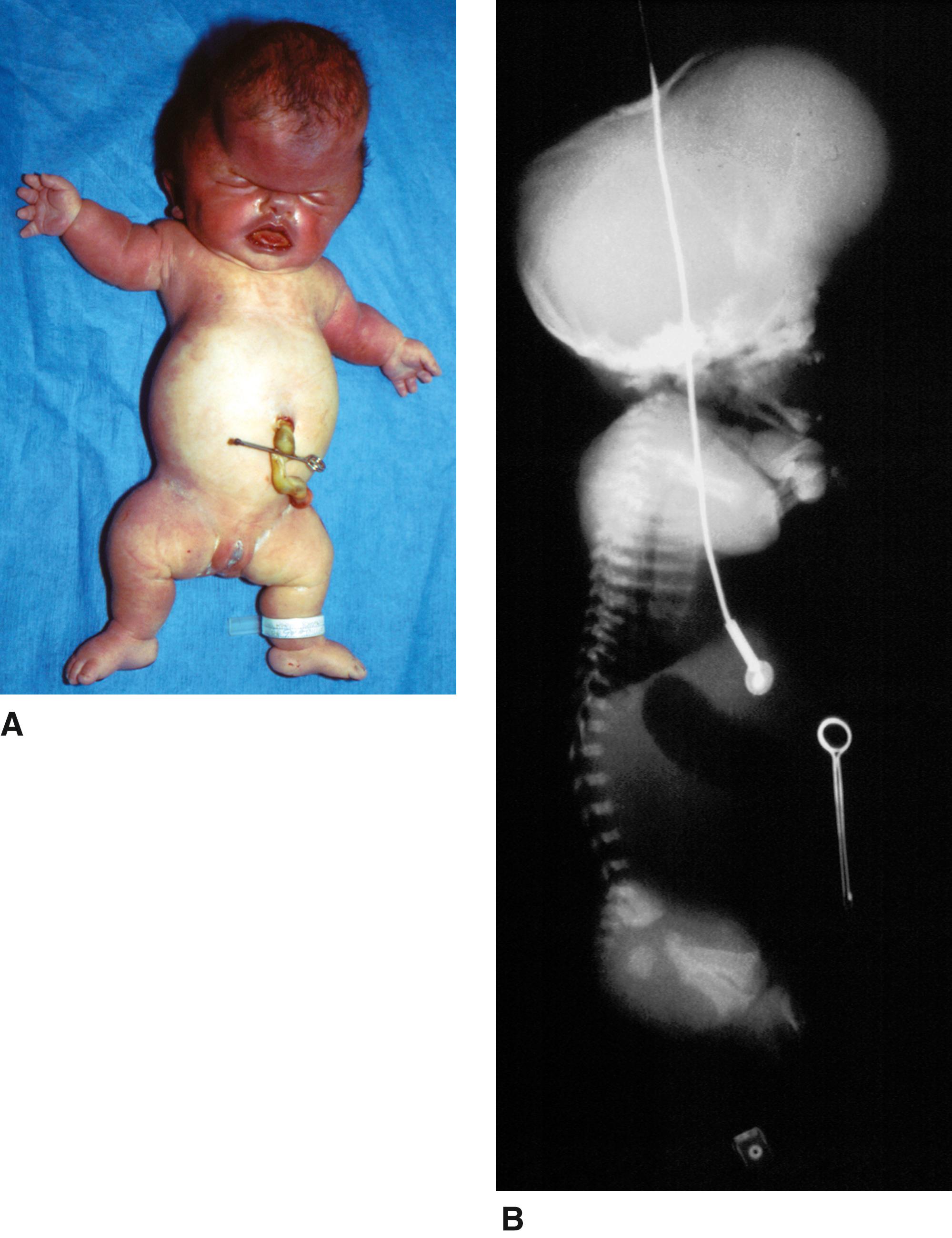
First described by Jeune and colleagues in 1955, more than 100 cases have now been reported.
Growth. Short stature (72%).
Skeletal. Infancy: Short horizontal ribs with irregular costochondral junctions and small thoracic cage (95%), hypoplastic iliac wings, horizontal acetabular roofs with spur-like projections at lower margins of sciatic notches, early ossification of capital femoral epiphysis. Childhood: Irregular epiphyses and metaphyses with rhizomelic shortening of limbs (88%), brachydactyly/micromelia (76%); relatively short ulnae and fibulae; cone-shaped epiphyses and early fusion between epiphyses and metaphyses of distal and middle phalanges.
Respiratory. Lung hypoplasia, presumably secondary to the small thoracic cage, is the major cause of death in early infancy.
Renal. Cystic tubular dysplasia or glomerular sclerosis (34%).
Hepatic. Biliary dysgenesis with portal fibrosis and bile duct proliferation (28%).
Polydactyly, usually of hands and feet, notching of distal end of metacarpal and metatarsal bones; lacunar skull; direct hyperbilirubinemia with prolonged jaundice; pancreatic defects, including fibrosis and cysts; Hirschsprung disease; retinal dysplasia/foveal hypoplasia (15%); lobation of the tongue and gingiva; cardiac defects (1.6%); abdominal muscle dysplasia; foregut dysmotility and malrotation; situs inversus; intellectual disability; Dandy-Walker complex.
Early death, usually the consequence of asphyxia with or without pneumonia, occurs frequently, almost always prior to 2 years of age. Procedures to expand the chest have been successful and should be considered in select cases. For those who survive, progressive improvement in the relative growth of the thoracic cage occurs and there may be only slight to moderate shortness of stature. However, respiratory difficulties occur in all survivors. Chronic nephritis leading to renal failure is a serious potential feature of this disorder occurring in approximately one-third of the 30% who have renal abnormalities. Renal insufficiency may be evident by 2 years of age and accounts for most deaths between 3 and 10 years of age. Although infrequent, progressive hepatic dysfunction also occurs and may contribute to the relatively poor long-term prognosis for individuals with this disorder. Survival to the fourth decade has occurred. However, little information is available for affected individuals older than 20 years.
This disorder has an autosomal recessive inheritance pattern. Mutations in IFT80, DYNC2H, TTC21B , WDR19 , and WDR34 are responsible. IFT80 encodes a protein that is important in intraflagellar transport and is essential for the development and maintenance of motile and sensory cilia. DYNC2H1 encodes a cytoplasmic dynein protein involved in retrograde transport in the cilia and functions in intraflagellar transport. TTC21B encodes the retrograde intraflagellar transport protein IFT139. Mutations of both IFT80 and DYNC2H have also been identified in short rib–polydactyly type III, suggesting that these two disorders are variants of the same condition.
A follow-up protocol has been proposed. In the first 2 years of life, focus should be on treatment of severe respiratory problems. Laboratory evaluation of urine and blood should be done twice a year, and abdominal ultrasound should be performed at 2, 5, 10, and 15 years. Spirometry should be done yearly, and an ophthalmology examination should be performed at 5 and 10 years of age.
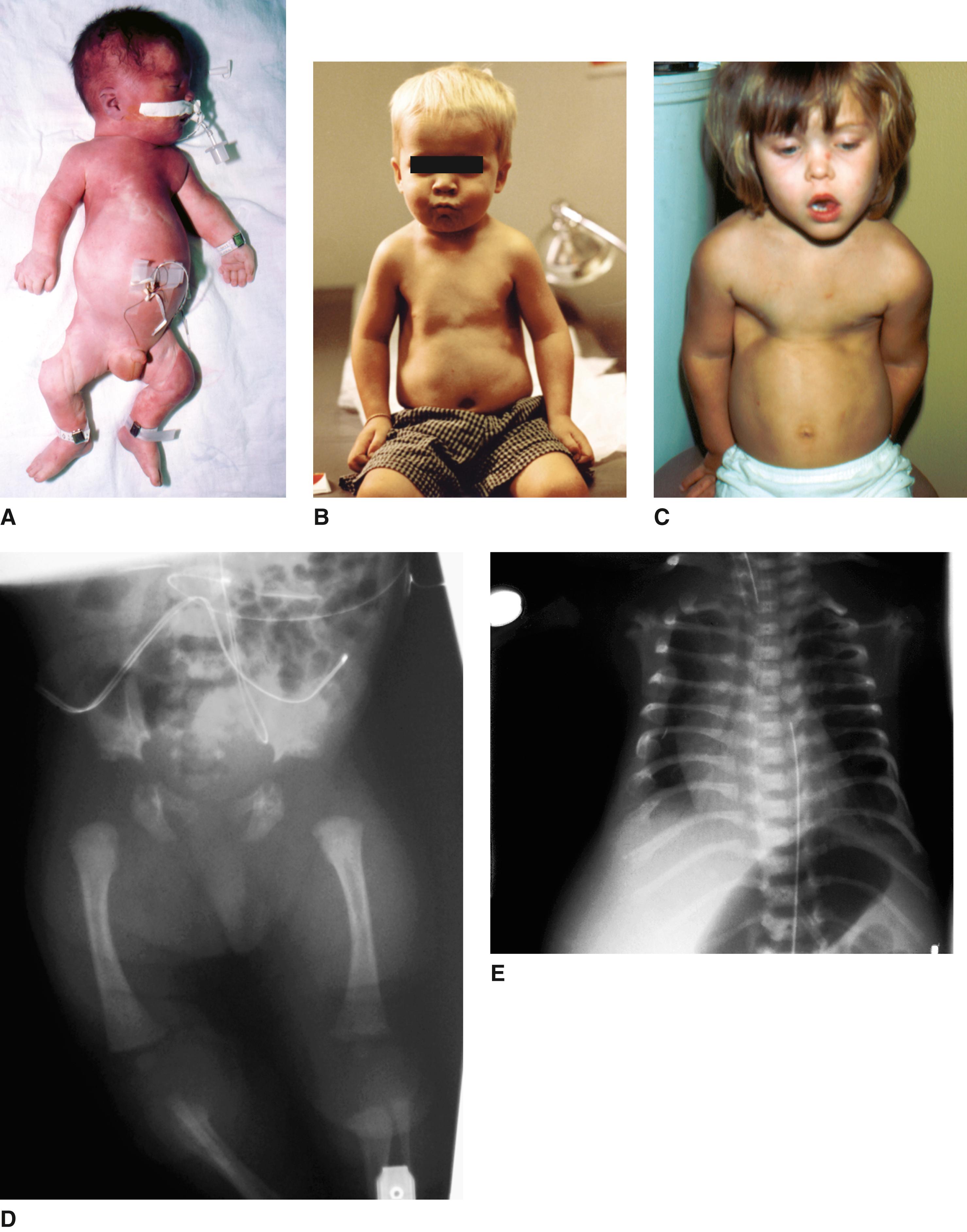
Although reports of this condition appeared in the 1950s by Bound and colleagues and Bain and Barrett, it was not until the 1970s that the syndrome became more broadly recognized by Spranger and colleagues and Maroteaux and colleagues, who used the term campomélique, meaning “bent limb,” to epitomize the disorder.
Growth. Prenatal onset of growth deficiency with retarded osseous maturation and large head; birth length, 35 to 49 cm; average occipitofrontal circumference is 37 cm.
Central Nervous System. Tendency toward having large brain with gross cellular disorganization, most evident in cerebral cortex, thalamus, and caudate nucleus; absence or hypoplasia of olfactory tract or bulbs; hydrocephalus.
Facies. Flat-appearing small face with high forehead, anterior frontal hair upsweep, large anterior fontanel, low nasal bridge, micrognathia, cleft palate, short palpebral fissures, and malformed or low-set ears.
Limbs. Anterior bowing of tibiae with skin dimpling over convex area, short fibulae, mild bowing of femora and tibiae, congenital hip dislocation, and talipes equinovarus.
Radiographic. Short and somewhat flat vertebrae, particularly cervical; hypoplastic scapulae, small thoracic cage with slender or decreased number of ribs, kyphoscoliosis, small iliac wings with relatively wide pelvic outlet; absent mineralization of sternum; lack of ossification of proximal tibial and distal femoral epiphysis and talus; short first metacarpal.
Tracheobronchial. Incomplete cartilaginous development with trachea-bronchio-malacia.
Genitalia. Sex reversal or ambiguous genitalia in about two-thirds of genetic males.
Cardiac defects, renal anomalies, polyhydramnios, hypoplastic cochlea and semicircular canals, anomalies of incus and stapes, hearing loss.
The great majority of patients die in the neonatal period from respiratory insufficiency. Although there have been some survivors with normal intelligence, most have mild to moderate intellectual disability. At birth the limbs are short with a trunk of normal length, but with development of the kyphoscoliosis, which is progressive, the trunk becomes short relative to the arms. Conductive hearing loss, myopia, dental caries, and recurrent apnea and respiratory problems are complications with advancing age. Absence of cervical and thoracic pedicles present a challenge during spine surgery.
Campomelic dysplasia (CD) has an autosomal dominant inheritance pattern, with most cases representing fresh gene mutations. The small number of recurrences are owing to gonadal mosaicism. Mutations in SOX9, a member of the SRY-related gene family, are responsible for the majority of cases. Acampomelic campomelic dysplasia (ACD) is associated with similar, but milder, skeletal abnormalities and lacks long bone curvature. However, in one case of ACD, bowing of the long bones was evident on prenatal ultrasound until the 18 th week of gestation. Although both CD and ACD can be caused by heterozygous mutations in SOX9 or chromosomal aberration affecting SOX9 or the putative enhancer region, the type of mutations and chromosomal aberrations differ. CD is primarily caused by nonsense or frameshift mutations or by chromosomal aberrations disrupting SOX9. ACD, on the other hand, is more often caused by missense mutations or by chromosomal aberrations affecting the enhancer region. SOX9 is involved in both bone formation and control of testes development. It regulates the expression of COL2A1 and is a transcription factor essential for chondrocyte differentiation and formation of cartilage.
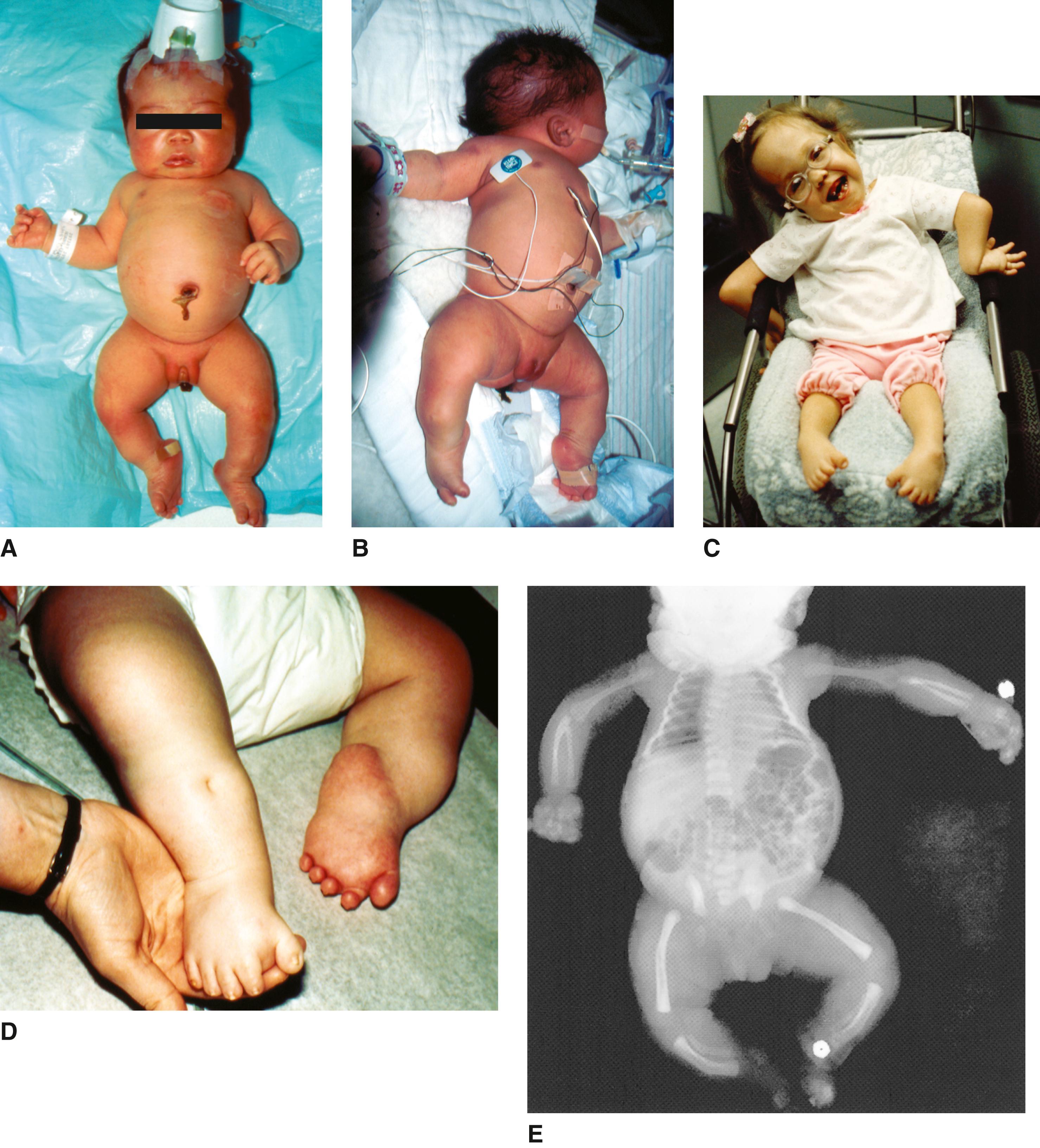
The most common chondrodysplasia, true achondroplasia, occurs with a frequency of approximately 1 in 15,000.
Growth. Small stature, mean adult height in males is 131 ± 5.6 cm and in females is 124 ± 5.9 cm.
Craniofacial. Megalocephaly, small foramen magnum, short cranial base with early sphenooccipital closure, low nasal bridge with prominent forehead, mild midfacial hypoplasia with narrow nasal passages.
Skeletal. Small cuboid-shaped vertebral bodies with short pedicles and progressive narrowing of lumbar interpedicular distance; lumbar lordosis, mild thoracolumbar kyphosis with anterior beaking of first or second lumbar vertebra; small iliac wings with narrow greater sciatic notch; short tubular bones, especially humeri; metaphyseal flare with ball-and-socket arrangement of epiphysis to metaphysis; short trident hand, fingers being similar in length, with short proximal and midphalanges; short femoral neck; incomplete extension of elbow.
Other. Mild hypotonia; early motor progress is often slow, although eventual intelligence is usually normal; temporal lobe abnormalities on MRI of the brain; relative glucose intolerance evident with an oral glucose tolerance test.
Hydrocephalus, spinal cord or root compression; pulmonary hypertension, synostosis of multiple sutures.
Macrocephaly may represent mild hydrocephaly relating to a small foramen magnum. Therefore, ultrasound studies of the brain should be performed if the fontanel size is particularly large, the occipitofrontal circumference increases too rapidly, head circumference above the 95th percentile, or any symptoms of hydrocephalus develop. Respiratory problems secondary to a small chest, upper airway obstruction, and sleep-disordered breathing are common. Cervical cord compression occurs frequently, leading to an increased risk for death in the first year of life. Indications for decompression include lower limb hyperreflexia, central apnea, and foramen magnum measurements below the mean for achondroplasia. Computed tomography dimensions for the foramen magnum of children with achondroplasia have been established by Hecht and colleagues. It is important to recognize that evaluation of affected children with symptoms relating to cervical cord compression should be performed by individuals experienced with, and aware of, the natural history of achondroplasia. Osteotomies for severe bowlegs are usually deferred until full growth has occurred. By discouraging the sitting position or other positions that cause the trunk to curve anteriorly until an age when good trunk strength has developed, a permanent gibbus or kyphosis, which is caused by anterior wedging of the first two lumbar vertebrae, can be prevented as well as obviating many of the problems with spinal stenosis and spinal cord compression that are so debilitating to adults with this condition. Exercises may also be used in an attempt to flatten the lumbosacral curve. Relative overgrowth of the fibula may accentuate bowing and require early stapling. Short eustachian tubes may lead to middle ear infection and conductive hearing loss. Tympanic membrane tubes may be indicated. Verbal comprehension is frequently impaired. Obstructive sleep apnea requiring oxygen supplementation is associated with airway malacia. The mandibular teeth may become crowded, possibly requiring removal of one or more. Todorov and colleagues developed a screening test that establishes normal milestones for children with achondroplasia up to 2 years of age. Some degree of developmental delay, primarily motor, is common, as is a decrease in IQ score compared with siblings. There is a tendency toward late childhood obesity, and females are more likely to have menorrhagia, fibroids, and large breasts. Complications from spinal stenosis increase in adults. By 10 years of age, a significant number of affected children have developed neurologic symptoms with claudication and increased reflexes in their legs. Long-term growth hormone treatment contributes to 2.6% and 2.1% of final adult height in males and females, respectively. Surgical leg lengthening is controversial because of the need for repeated surgeries, the long period of time that orthopedic appliances must be used, superficial infections, and the stretching of nonskeletal tissues. The average life expectancy is decreased by 15 years.
This disorder has an autosomal dominant inheritance pattern; approximately 90% of the cases represent a fresh gene mutation. Older paternal age has been a contributing factor in these cases. Because of gonadal mosaicism, there is a 0.2% recurrence risk for siblings of achondroplastic children with unaffected parents. Mutations in the gene encoding fibroblast growth factor receptor 3 ( FGFR3 ), located at 4p16.3, have been documented in all cases reported to date. Interestingly, virtually all cases demonstrate the same single base pair substitution, possibly accounting for the consistency of the phenotype seen in this disorder.
Health Supervision Guidelines for Children with Achondroplasia have been established by the American Academy of Pediatrics. An excellent review has been published by Richard Pauli in 2019.
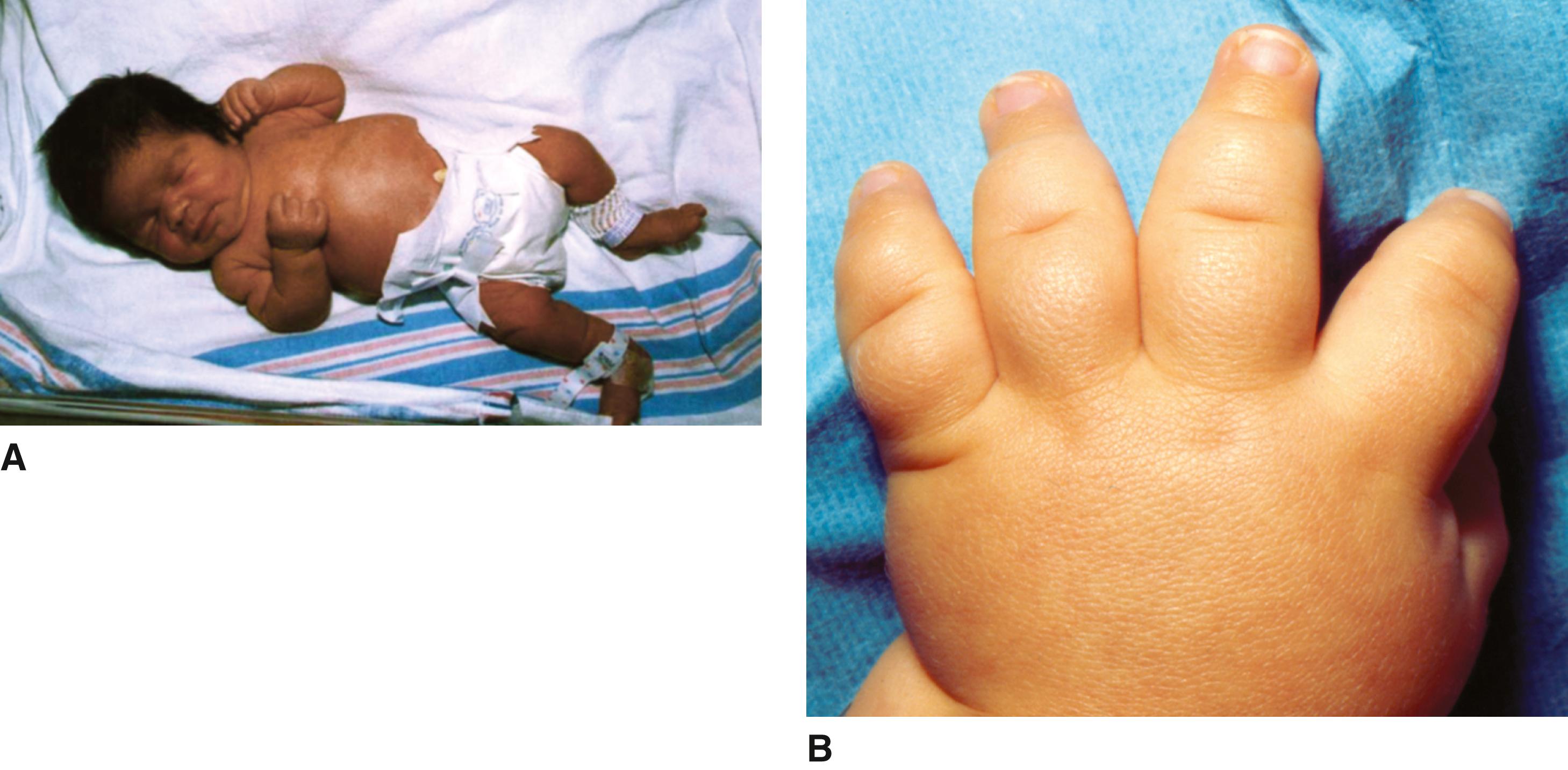
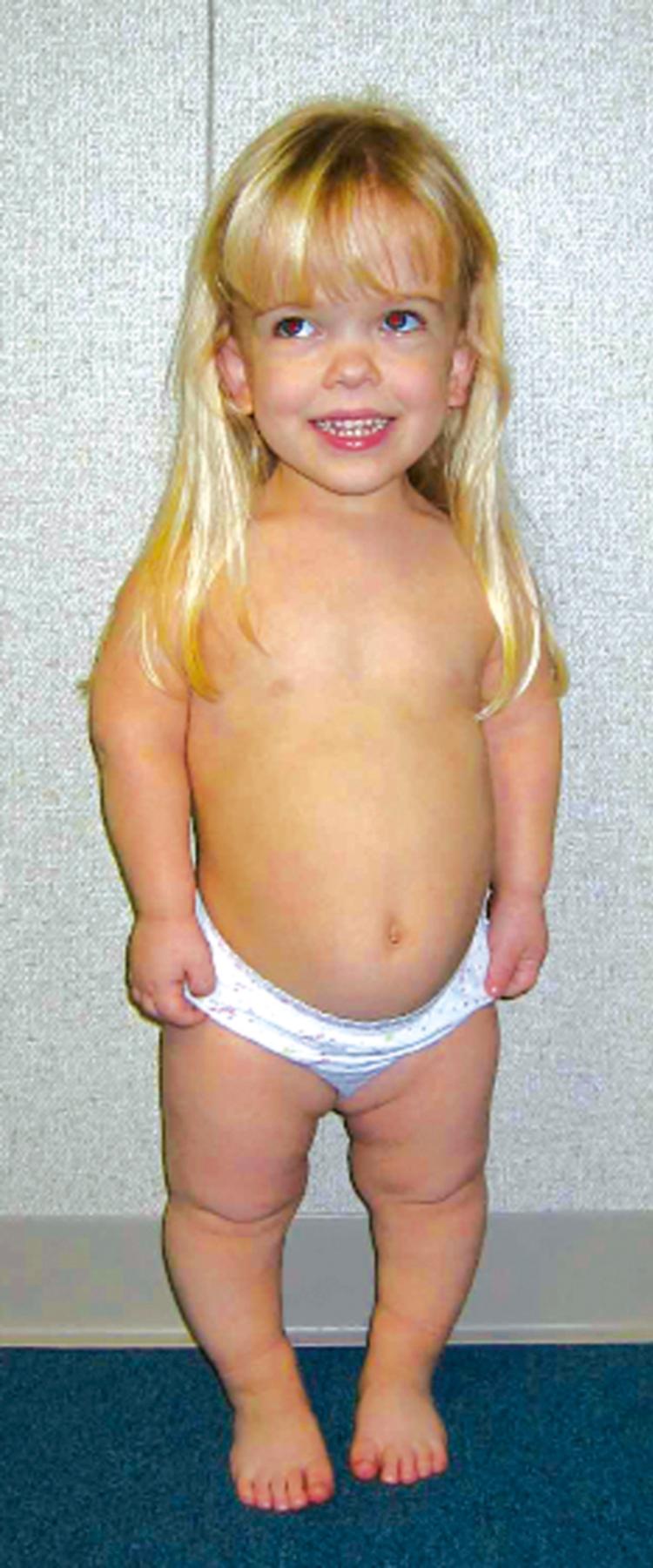
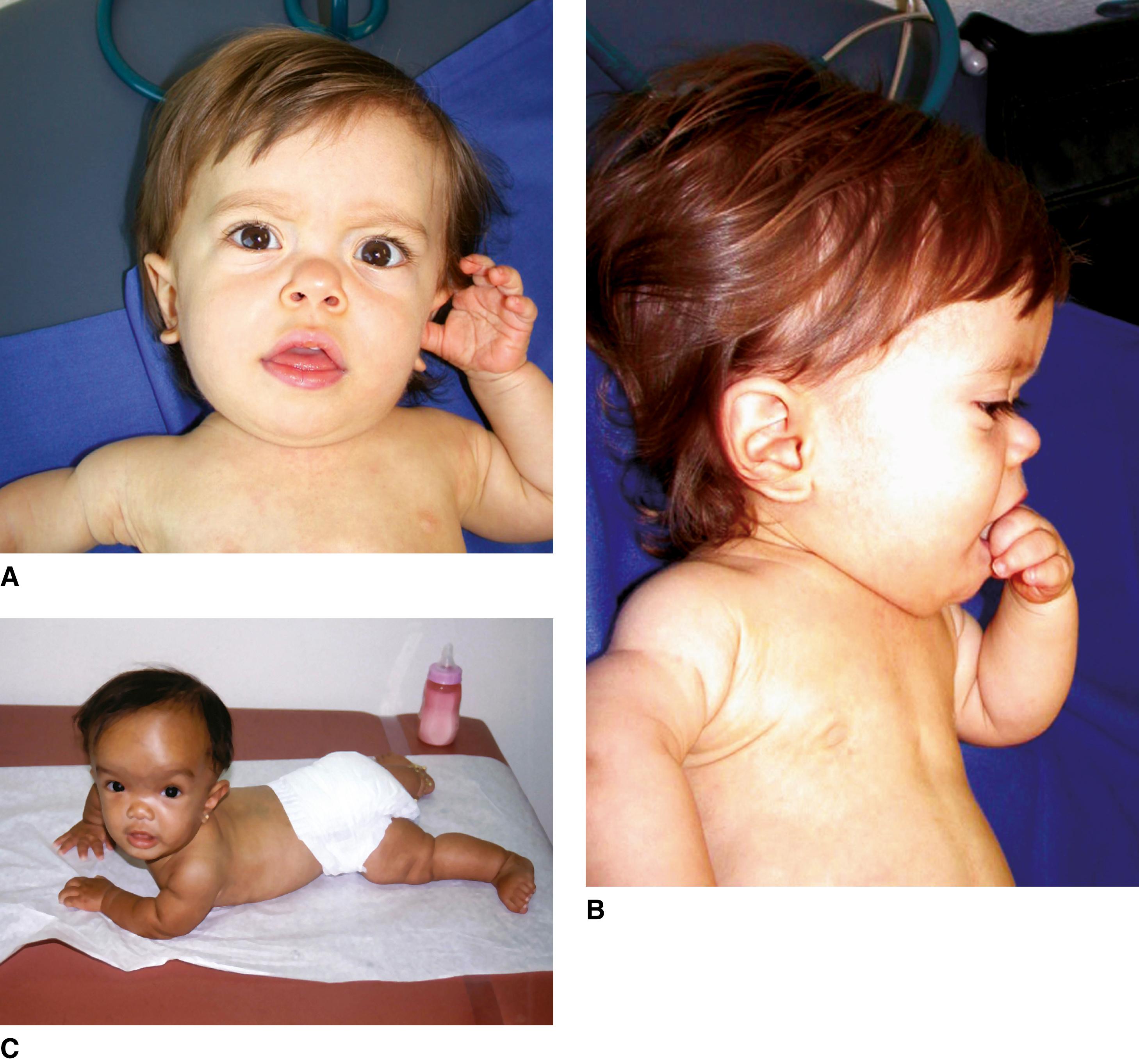
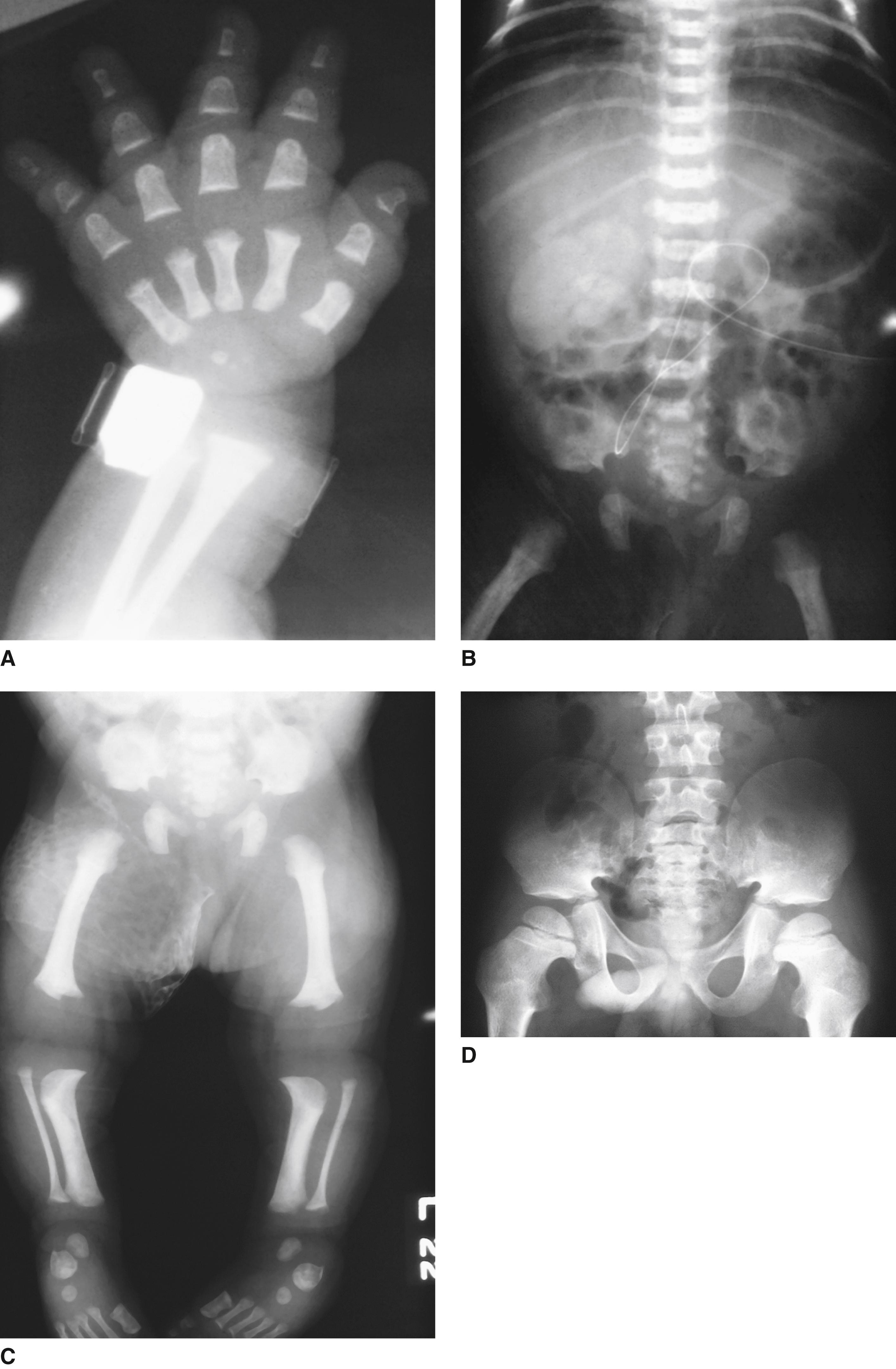
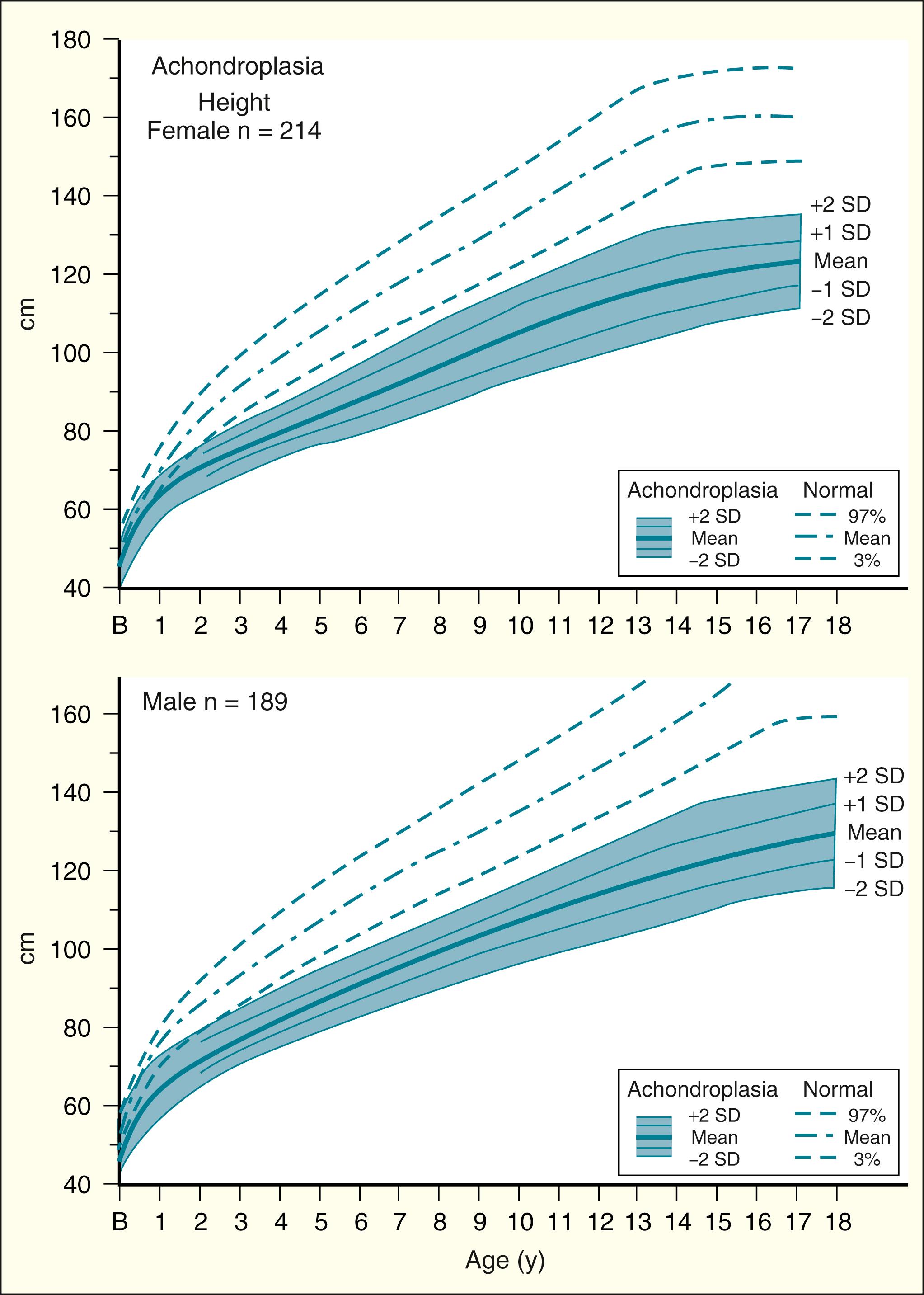
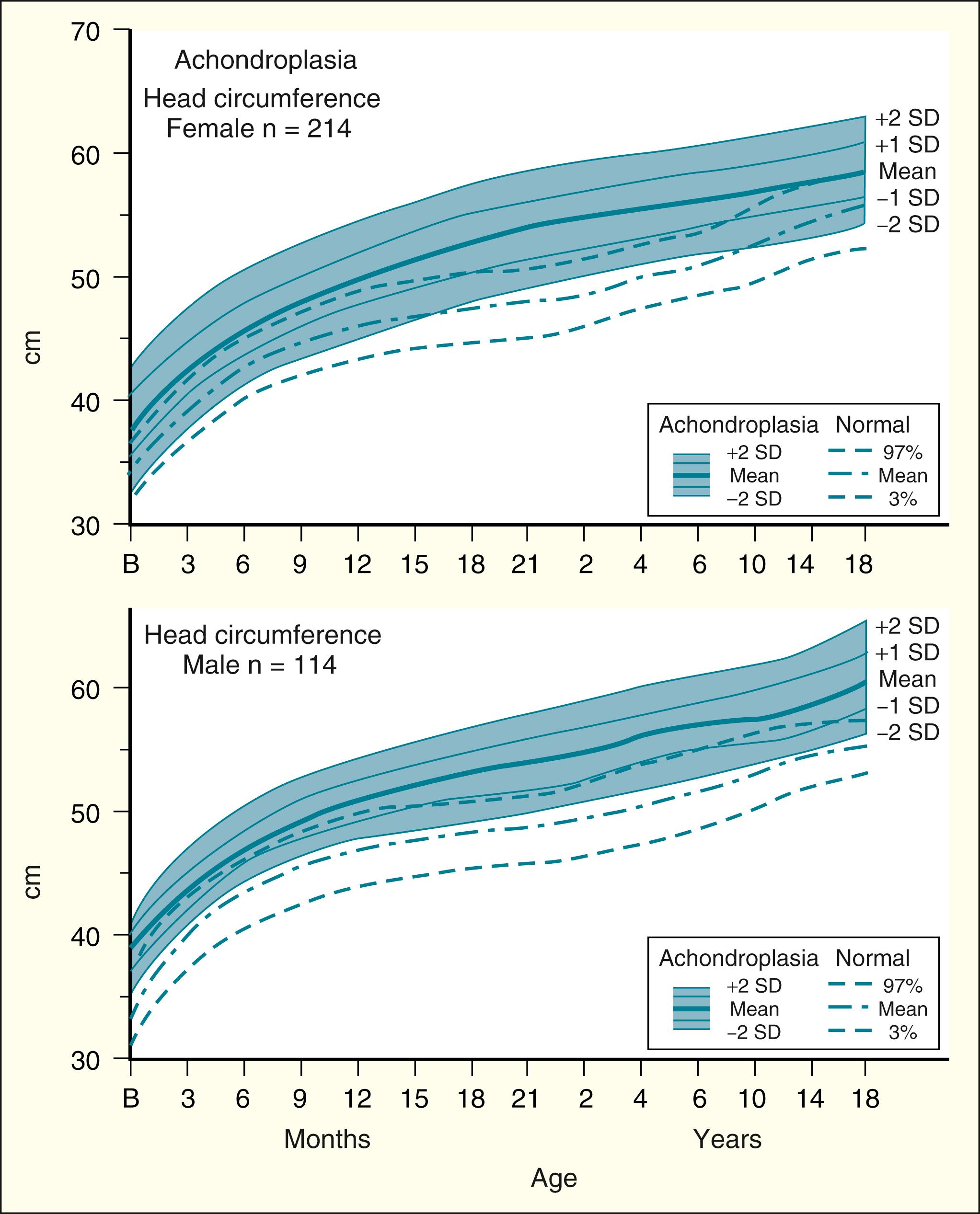
Although the features of this disorder were described by Ravenna in 1913, and its designation as hypochondroplasia and mode of inheritance were set forth in 1924, the majority of cases have been misdiagnosed as achondroplasia until recently.
Hypochondroplasia has an incidence of approximately one twelfth that of achondroplasia; it can be distinguished from it by the relative lack of craniofacial involvement and milder features in the hands and spine.
Become a Clinical Tree membership for Full access and enjoy Unlimited articles
If you are a member. Log in here